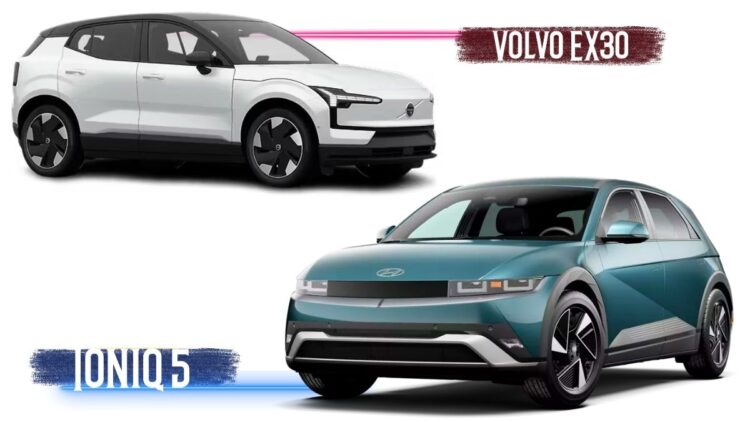The Volvo EX30 and the Hyundai Ioniq 5 are electric SUVs with powerful batteries. The exterior of this car is totally aerodynamic, and the interior is spacious. The EX30 is available with an ex-showroom price of ₹41 lakh, and the same for the Ioniq 5 is ₹46 lakh.
These cars are available with a rear-wheel drive option, and the available transmission is automatic. In terms of safety features, these two EVs are quite similar. But the dimensions, i.e., length, width, height, and wheelbase, are different from one another.
These electric cars are totally different from one another in terms of powertrain, specifications, and features. Here, we have shared the side-by-side comparison between these two EVs; read this article to make a conclusion about which one provides more value.
Powertrain
The EX30 and Ioniq 5 are available with different battery packs, so their power output and torque also vary. The acceleration timing for Volvo’s car is quicker, and the same for Hyundai’s vehicle is smooth and balanced. Check the comparison from below.
| Feature | Volvo EX30 | Hyundai Ioniq 5 |
| Battery Capacity | ~69 kWh | 72.6 kWh |
| Power Output | ~272 hp | ~215 hp |
| Torque | ~343 Nm | ~350 Nm |
| Drivetrain | RWD | RWD |
| Range (Claimed) | ~480 km | ~631 km |
| Fast Charging | Up to 150 kW | Up to 350 kW |
| 10–80% Charge Time | ~26 min | ~18 min |
| Real-World Efficiency | Moderate | Higher due to aero design |
| Drive Feel | Sporty & compact | Smooth, stable & spacious |
Design & Exterior
The EX30’s body type is a compact SUV, and the Ioniq 5 is a mid-size crossover. The exterior of both EVs is aerodynamic to give them a catchy appearance; check the side-by-side comparison for the design and exterior from the table available below.
| Feature | Volvo EX30 | Hyundai Ioniq 5 |
| Design Theme | Minimal & Scandinavian | Futuristic & retro-modern |
| Headlights | Thor’s Hammer LED | Parametric Pixel LED |
| Body Style | Compact SUV | Mid-size electric crossover |
| Aerodynamics | Clean surfaces | High aero efficiency |
| Wheels | 18–20 inch | 19–20 inch |
| Door Handles | Flush-type | Flush-type |
| Overall Stance | Sporty & upright | Wide, futuristic look |
| Build Appeal | Premium Volvo styling | EV-first bold design |
| Rear Design | Clean LED bar | Pixel-style tail lamps |
| Road Presence | Moderate | Very strong |
Interior & Technology
The interiors of these electric cars have many similarities; both have large-screen infotainment systems. Refer to the table to check the side-by-side comparison between the EV from Volvo and Hyundai.
| Feature | Volvo EX30 | Hyundai Ioniq 5 |
| Dashboard Layout | Minimal with single-screen | Dual wide-screen dashboard |
| Touchscreen | 12.3-inch vertical | 12.3-inch infotainment + 12.3-inch cluster |
| Instrument Cluster | Digital | Fully digital separate unit |
| Connectivity | Wireless CarPlay/AA | Wired CarPlay/AA |
| Sound System | Premium options | Bose sound system |
| Materials | Recycled & sustainable | Eco-friendly + premium upholstery |
| Cabin Ambience | Simple, modern | Spacious, lounge-like |
| Features | Google built-in OS | V2L, memory seats, more controls |
| Storage Space | Compact layout | Very roomy with sliding console |
| Tech Feel | Clean and tech-light | Feature-rich and futuristic |
Safety & Comfort
To ensure the safety of the driver and passenger, both EVs have quite similar advanced safety features. They have multiple airbags, which play a crucial role in saving lives during a collision. The comparison for features that give both safety and comfort is:
| Feature | Volvo EX30 | Hyundai Ioniq 5 |
| NCAP Rating | 5-star global | 5-star global |
| ADAS | Full Volvo ADAS | Hyundai SmartSense ADAS |
| Airbags | 6 airbags | 6 airbags |
| Chassis Safety | High Volvo safety standards | Strong E-GMP platform |
| Ride Comfort | Firm but stable | Softer, more comfortable |
| Seating | Supportive | Spacious with recline features |
| Cabin Noise | Well insulated | Very refined |
| Climate Control | Advanced A/C | Dual-zone A/C |
| Driver Assistance | Strong active safety | Wide ADAS feature list |
| Overall Safety Feel | Volvo-first approach | High-tech but comfort-focused |
Dimension & Space
In terms of length, Hyundai’s EV is quite larger than Volvo’s. Their width, height, wheelbase, ground clearance, boot space, etc., are totally different from one another. Check the comparison for dimensions and space from the table available below.
| Feature | Volvo EX30 | Hyundai Ioniq 5 |
| Length | ~4,233 mm | ~4,635 mm |
| Width | ~1,838 mm | ~1,890 mm |
| Height | ~1,550 mm | ~1,625 mm |
| Wheelbase | ~2,650 mm | 3,000 mm |
| Boot Space | Moderate | Large & practical |
| Rear Seat Space | Compact | Very spacious |
| Legroom | Tight | Excellent |
| Headroom | Adequate | Generous |
| Cabin Width | Medium | Wide & airy cabin |
| Overall Space | Compact SUV | Larger crossover |
The Ioniq 5 provides more value because it offers a much larger cabin and more range with a slightly higher price, and the EX30 is a premium and sporty EV, but the Ioniq 5 gives more space and capability for the money.








